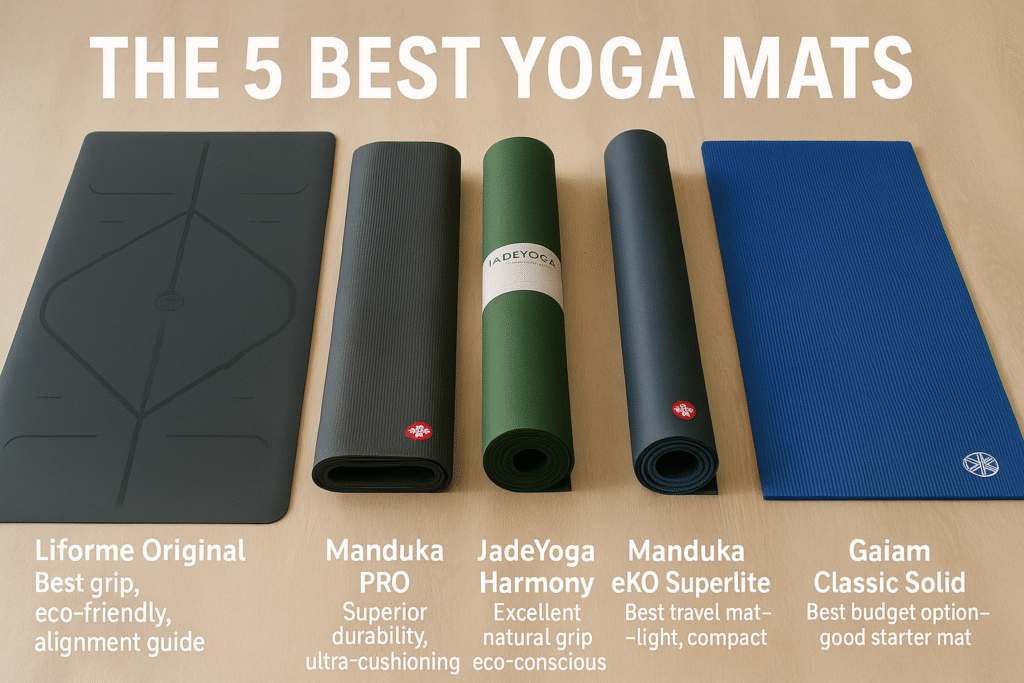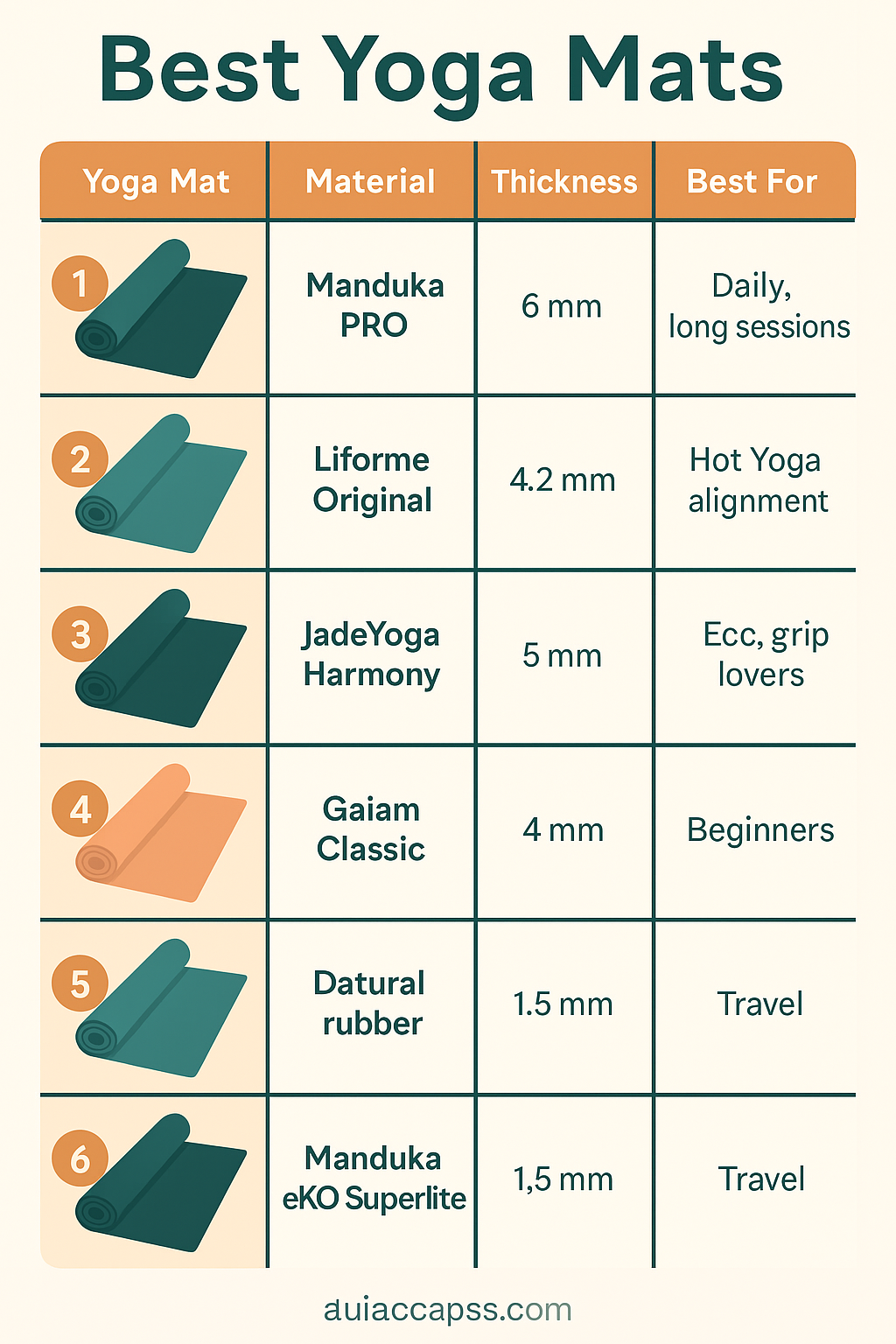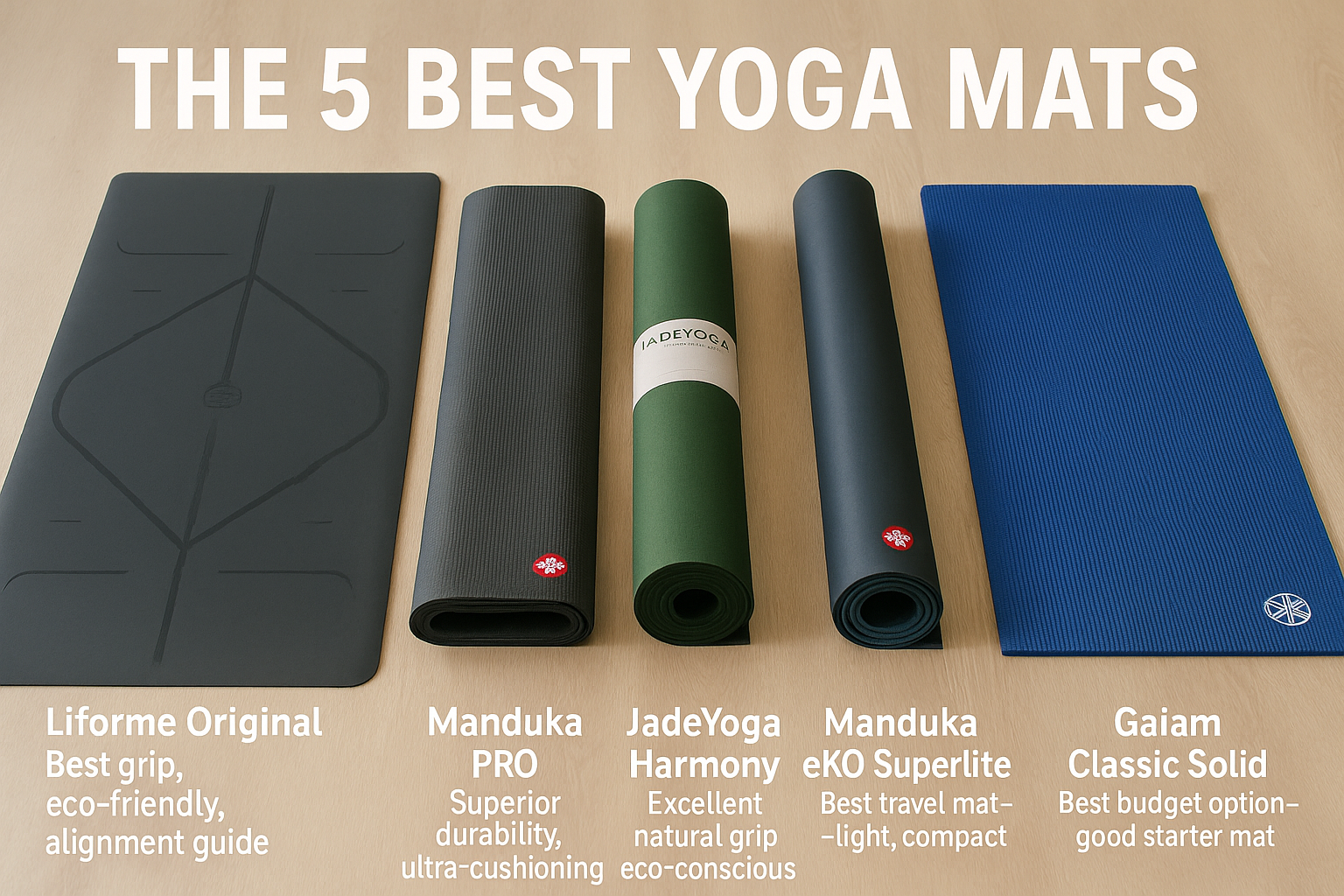
Introduction: How to Choose the Best Yoga Mat for Your Practice
The best yoga mats are more than just fitness accessories—they are the foundation of your yoga journey. A well-chosen mat supports your body, enhances your flow, and nurtures your peace of mind with every pose.
As a passionate yoga enthusiast, you understand how the right mat can influence your comfort, stability, and focus. But with countless options—thick or thin, grippy or smooth, eco-friendly or travel-friendly—finding the perfect one can feel overwhelming.
That’s why this guide is here to help. We’ve reviewed and compared the best yoga mats to help you feel informed, confident, and grounded in your choice, whether you’re practicing hot vinyasa, gentle yin, or meditative breathwork.
Feeling Anxious About Mat Comfort & Stability? You’re Not Alone.
If you’re worried about joint comfort, slipping during poses, or feeling unsupported during your practice, take a deep breath. These concerns are common—and absolutely valid.
Here are some suggestions to ease your mind:
1. Choose the Right Thickness for Your Body
- If you have sensitive knees or wrists, opt for a mat at least 5–6 mm thick like the Manduka PRO.
- If you prefer grounded stability for balancing poses, a 3–4 mm mat like the Liforme Original offers just enough cushioning without compromising grip.
2. Prioritize Grip to Prevent Slipping
- Worried about sweaty hands? Mats like JadeYoga Harmony or Liforme offer excellent wet traction, so you stay grounded even in hot yoga.
- You can also pair your mat with a yoga towel for extra security.
3. Practice at Home First
If you’re trying a new mat, unroll it in your home studio first. Get a feel for its surface, cushioning, and size with a few sun salutations before bringing it to class.
4. Comfort Is Personal—Trust Your Practice
What feels perfect for one yogi may not feel right for another. Trust your body’s feedback. If a mat helps you feel stable, cushioned, and at ease, it’s the right one for you.
The Best Yoga Mats: In-Depth Comparison & Review
Choosing the right yoga mat can transform your practice. Whether you’re a beginner, hot yoga enthusiast, or eco-conscious yogi, the right mat supports your flow, comfort, and stability. Here’s a comprehensive comparison of 5 of the best yoga mats available today:
1. Manduka PRO Yoga Mat
Material & Sustainability:
Made from high-density PVC, the Manduka PRO is built to last a lifetime. It’s OEKO-TEX® certified but not biodegradable, which may be a drawback for eco-purists.
Thickness & Cushioning:
6 mm of ultra-dense cushioning offers excellent joint support—ideal for long sessions or hardwood floors.
Grip & Traction:
Initially slick but improves with use or salt scrubbing. It excels in dry grip but may need a towel for sweaty sessions.
Size & Dimensions:
Available in standard (71″) and long (85″), with a 26″ width—great for all body types.
Weight & Portability:
Heavy at 7.5 lbs. Not ideal for travel or carrying to classes.
Durability:
Extremely durable; backed by a lifetime warranty. Doesn’t flake or tear over time.
Ease of Cleaning:
Closed-cell surface resists sweat and bacteria. Wipe clean easily.
Certifications:
OEKO-TEX® certified, free of harmful chemicals.
Price & Value:
Premium price, but offers lifetime value.
Best For:
Serious yogis, tall practitioners, or anyone needing maximum joint support.
2. Liforme Original Yoga Mat
Material & Sustainability:
Made from eco-polyurethane and natural rubber. Biodegradable and PVC-free. Very eco-friendly.
Thickness & Cushioning:
4.2 mm – well-balanced between cushioning and stability.
Grip & Traction:
Exceptional grip even when sweaty—arguably the best in class. No towel needed for hot yoga.
Size & Dimensions:
72.8″ x 26.8″ – longer and wider than standard mats.
Weight & Portability:
Moderate weight at 5.5 lbs. Comes with a carry bag.
Durability:
Durable but can show wear over time with intense use.
Ease of Cleaning:
Open-cell surface absorbs sweat—needs more frequent cleaning.
Certifications:
Eco-friendly materials, PVC-free.
Price & Value:
Higher price point, but excellent performance and eco-consciousness.
Best For:
Hot yoga, eco-conscious practitioners, and alignment-focused yogis.
3. JadeYoga Harmony Mat
Material & Sustainability:
Made from natural rubber tapped sustainably from rubber trees. Biodegradable and made in the USA.
Thickness & Cushioning:
5 mm – good balance of comfort and stability.
Grip & Traction:
Superb traction both dry and wet. Great for vinyasa and power yoga.
Size & Dimensions:
68″, 71″, and 74″ lengths available. Width: 24″.
Weight & Portability:
Around 5 lbs—manageable for most users.
Durability:
Natural rubber wears faster than PVC but still lasts well with care.
Ease of Cleaning:
Absorbs moisture; needs regular cleaning and air-drying.
Certifications:
Eco-conscious, free from PVC, EVA, or synthetic rubber.
Price & Value:
Mid-high price. Jade plants a tree for every mat sold.
Best For:
Vinyasa practitioners, eco-conscious yogis, and anyone wanting a naturally grippy surface.
4. Gaiam Classic Solid Yoga Mat
Material & Sustainability:
Made from PVC. Not biodegradable but free from latex and harmful phthalates.
Thickness & Cushioning:
4 mm – decent cushioning for beginners.
Grip & Traction:
Moderate grip; may slip when wet. Not ideal for hot yoga.
Size & Dimensions:
68″ x 24″ – standard size.
Weight & Portability:
Lightweight at 3 lbs—easy to carry.
Durability:
Less durable than premium mats but fine for occasional practice.
Ease of Cleaning:
Closed-cell design makes it easy to wipe clean.
Certifications:
Free of DEHP, DBP, BBP, DINP, DIDP, and DNOP.
Price & Value:
Very affordable—great for casual or beginner yogis.
Best For:
Budget-conscious beginners and light home practice.
5. Manduka eKO Superlite Travel Mat
Material & Sustainability:
Made from biodegradable natural rubber. No PVC or harmful plasticizers.
Thickness & Cushioning:
1.5 mm – super thin for portability, not for those needing joint support.
Grip & Traction:
Very grippy, even when sweaty. Great for travel hot yoga.
Size & Dimensions:
68″ x 24″ – folds easily into a suitcase or backpack.
Weight & Portability:
Extremely light at 2.2 lbs – perfect for travelers.
Durability:
Fair durability for a travel mat. Will wear faster with heavy daily use.
Ease of Cleaning:
Wipe down after use and air dry. Avoid direct sun.
Certifications:
Eco-friendly materials and dyes.
Price & Value:
Affordable for a travel mat. Good balance of portability and grip.
Best For:
Traveling yogis, minimalist packers, and hot yoga on the go.
At a Glance: Quick Comparison Table
| Yoga Mat | Material | Thickness | Weight | Best For |
| Manduka PRO | PVC (non-toxic) | 6 mm | 7.5 lbs | Daily, long sessions |
| Liforme Original | Natural rubber + PU | 4.2 mm | 5.5 lbs | Hot yoga, alignment |
| JadeYoga Harmony | Natural rubber | 5 mm | 5 lbs | Eco & grip lovers |
| Gaiam Classic | PVC (phthalate-free) | 4 mm | 3 lbs | Beginners |
| Manduka eKO Superlite | Natural rubber | 1.5 mm | 2.2 lbs | Travel |

Final Verdict: Which Yoga Mat is the Best?
- Best Overall Performance: Liforme Original
- Best for Durability & Lifetime Value: Manduka PRO
- Best Eco-Friendly Option: JadeYoga Harmony
- Best Budget Mat: Gaiam Classic Solid
- Best Travel Yoga Mat: Manduka eKO Superlite
Buying Guide: How to Choose the Best Yoga Mat
When shopping for the best yoga mats, keep the following key factors in mind:
1. Practice Type
- Hot Yoga or Power Flow? Choose a mat with high sweat traction like the Liforme or JadeYoga Harmony.
- Gentle or Restorative Yoga? A cushioned mat like the Manduka PRO provides more comfort.
2. Joint Support
- If you have sensitive knees or wrists, go for thicker mats (5–6 mm).
- For travel or grounding poses, thinner mats (1–3 mm) offer better stability.
3. Grip and Traction
l Dry Grip: Manduka PRO (once broken in)
l Wet Grip: Liforme Original, JadeYoga Harmony
l Add a yoga towel for extra traction if needed.
4. Eco-Friendliness
- Prioritize mats made from natural rubber, recycled materials, or biodegradable sources (Liforme, JadeYoga, eKO Superlite).
5. Budget
- Beginners can start with Gaiam or eKO Superlite.
- Intermediate and advanced yogis may invest in Liforme or Manduka PRO for long-term use.
Where to Buy the Best Yoga Mats
Below are affiliate links to Amazon and official websites to help you shop easily:
| Yoga Mat | Buy on Amazon | Buy from Brand |
| Manduka PRO | Amazon Link | Manduka.com |
| Liforme Original | Amazon Link | Liforme.com |
| JadeYoga Harmony | Amazon Link | JadeYoga.com |
| Gaiam Classic Solid | Amazon Link | Gaiam.com |
| Manduka eKO Superlite | Amazon Link | Manduka.com |
Disclosure: These are affiliate links. If you purchase through them, we may earn a small commission at no extra cost to you.
Quick Yoga Mat Quiz: Find Your Perfect Match
Answer these 5 quick questions to narrow down which mat might be best for you!
1. What type of yoga do you practice most often?
A. Hot Yoga / Power Yoga
B. Yin / Restorative Yoga
C. Hatha / Vinyasa / Mixed styles
D. I travel a lot and need a compact mat
2. What’s most important to you?
A. Maximum grip (especially when sweaty)
B. Soft cushioning for joints
C. A balance between grip, comfort, and eco-friendliness
D. Portability and lightweight design
3. How often do you practice?
A. 5–7 times per week
B. 2–4 times per week
C. Occasionally or when I travel
4. Are you eco-conscious when choosing gear?
A. Yes, I prefer natural or biodegradable materials
B. Not a priority, I just want something durable
C. I’d like a good balance of both
5. What’s your budget range?
A. Under $50
B. $50–$100
C. $100+
Your Match Based on Answers:
| Mostly A’s | Try Liforme Original or JadeYoga Harmony – excellent grip & eco-friendly |
| Mostly B’s | Go for Manduka PRO – ultra-cushioned and long-lasting |
| Mostly C’s | Manduka eKO Superlite or Gaiam Classic – great value + versatility |
| Mostly D’s | Manduka eKO Superlite – the perfect mat for travel and compact storage |
Frequently Asked Questions (FAQ)
Q1: What’s the ideal yoga mat thickness for beginners?
A: A mat between 4–6 mm gives you a nice balance of comfort and stability. If you have sensitive knees or wrists, go for thicker (6 mm+).
Q2: Can I use the same mat for hot yoga and restorative yoga?
A: You can, but it’s best to use a mat with excellent grip (like Liforme or JadeYoga) for sweaty sessions and a cushioned mat (like Manduka PRO) for restorative poses.
Q3: Are eco-friendly mats durable?
A: Yes! Mats made from natural rubber (like JadeYoga or Liforme) are durable with proper care. Just avoid leaving them in the sun or soaking them in water.
Q4: How do I clean my yoga mat?
A: Use a mat-friendly cleaner (water + mild soap or vinegar solution). Wipe it down after each use and let it air dry completely before rolling it up.
Q5: What size yoga mat should I buy?
A: Standard mats are 68″ long. If you’re taller than 5’10”, go for a mat 72″ or longer (like Manduka PRO Long or Liforme Original).
Call-To-Action (CTA) to Close the Post
Your practice deserves the best foundation.
Whether you crave grip, cushioning, or eco-conscious materials, there’s a perfect mat for you.
Have a favorite yoga mat we missed? Drop it in the comments below!
�� Don’t forget to check out our full yoga gear guide [link to another post or product page].
Practice with intention. Flow with confidence.
Best wishes from Benvitalfive



